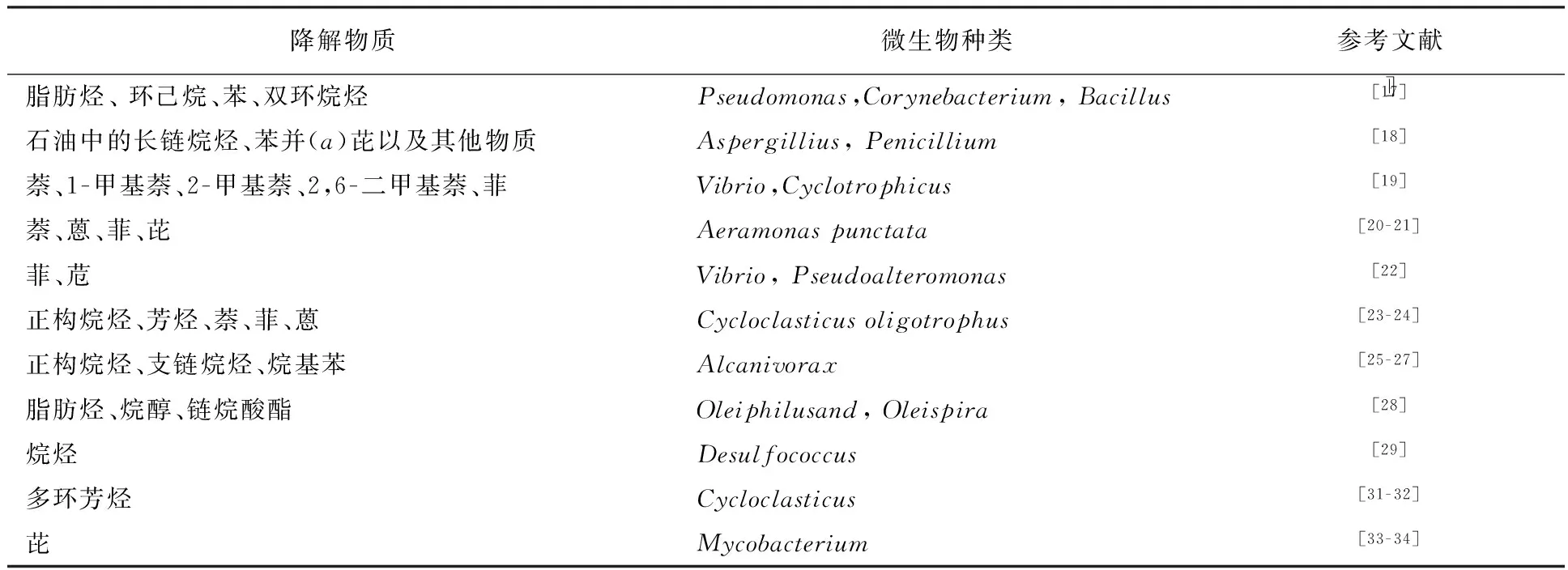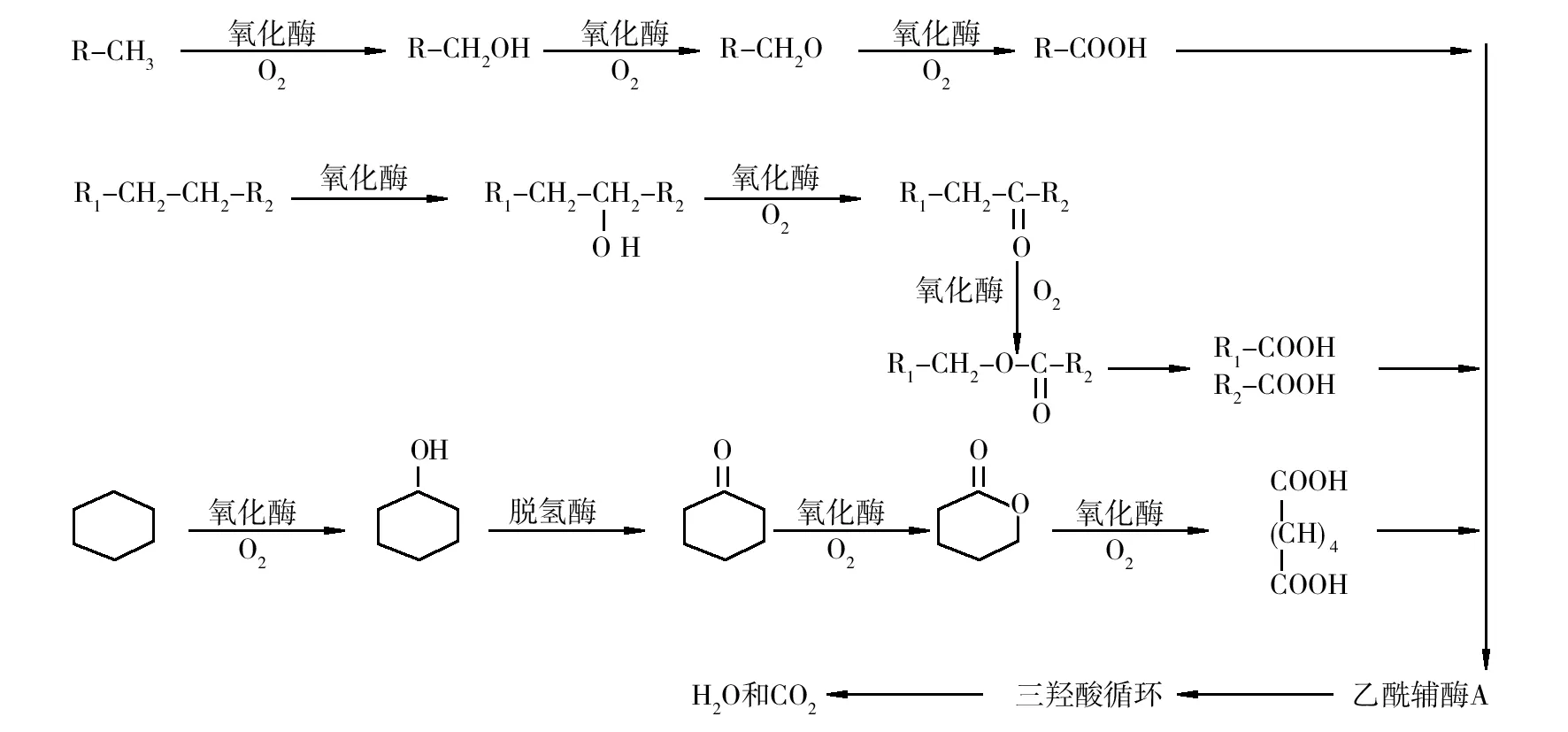海洋石油降解微生物及其降解机理
2017-01-03张耀尹曹雪洁于基成
刘 秋, 张耀尹, 曹雪洁, 郭 浩, 于基成
(大连民族大学 生命科学学院,辽宁 大连 116600)
·大家专版·
海洋石油降解微生物及其降解机理
刘 秋, 张耀尹, 曹雪洁, 郭 浩, 于基成
(大连民族大学 生命科学学院,辽宁 大连 116600)
微生物修复作为一种新型环保的生物修复技术,已成为海洋石油污染生物修复的核心技术。对海洋石油降解微生物的种类即细菌、蓝藻、真菌以及藻类进行了总结,对微生物对石油烃的降解途径与降解机理进行了综述。微生物降解烷烃的过程包括末端氧化、烷基氢过氧化物以及环己烷降解3种形式。微生物对芳香烃的降解是通过芳香烃被氧化酶氧化导致苯环开环来实现的。微生物对多环芳烃的降解是在单加氧酶或双加氧酶的催化作用下被最终降解为二氧化碳和水而被分解。并对影响石油烃降解微生物的因素包括温度、营养物质等因素进行了分析。
石油降解;海洋微生物;机理
随着我国城市工业化和城镇化的脚步越来越快,能源的需求量与日俱增。海上原油运输、近海采油平台及油港数量急剧上升。随之而来的海上原油开采、运输和装卸过程中突发的漏油、溢油事故日益增多,导致海洋环境中的石油污染状况日趋严重,使海洋环境和海洋生态遭受到前所未有的破坏。如2010年7月,大连新港发生输油管道爆炸事故,导致约1 500 t的原油流入海洋,造成430余平方公里海面污染的重大损失,引起了社会的广泛关注。时隔一年的2011年6月,山东蓬莱19-3油田发生的溢油事故导致大量原油和油基泥浆泄漏入海,严重破坏了环渤海的生态环境。此次事故造成油田周边及其西北部海域约870余平方公里海面受到严重污染,海水中石油含量严重超标。这些日益严重的海洋溢油污染已经成为我国近海海域的主要污染物。国家海洋局2015年发布的中国海洋环境状况公报中指出石油类已经成为我国近海海域主要三大污染要素之一,污染海域主要分布在辽东湾、渤海湾、莱州湾、江苏沿岸、长江口、杭州湾、浙江沿岸、珠江口等近岸海域,我国近海海域的石油污染形势已经非常严峻[1]。 日益严重的海洋石油污染事件引起了世界各国相关管理部门及生态学家的密切关注。如何科学、高效地去除石油污染已经成为亟待解决的科学和社会问题[2]。目前,常用于治理石油污染的方法包括物理法、化学法和生物修复。其中生物修复技术以其价格低廉、处理效果好、无二次污染、可对石油污染区域进行原位修复等优势被视为最经济有效和最具使用前景的环境治理措施[3]。目前,生物修复作为一种新型环保的修复技术,已得到世界环保部门的认可。而海洋环境的特殊性则使其中的微生物修复技术成为了海洋石油污染的核心生物技术。1989年美国在Exxon Vadez 油轮石油泄漏事故中应用生物修复技术,在短时间内通过富集石油降解微生物清除了石油污染,治理了环境,是微生物修复成功应用的开端[4]。
1 海洋环境中石油降解微生物的种类与分布
自20世纪40年代以来,世界有关国家就陆续开始石油烃的生物降解及环境的生物修复技术研究[5-6]。这些研究表明,不同种类的石油降解微生物在海洋环境中分布广泛。一旦海洋中其他的优势类微生物种群受到石油污染的抑制,那么与此同时那些具有石油降解功能的微生物则会迅速繁殖并成为海洋中的优势种群。目前在海洋环境中,已经发现超过100多个属的200多种微生物能够降解石油,其中包括细菌(79个属)、蓝藻(9个属)、真菌(103个属)以及藻类(19个属)[7-10]。
在海洋环境中,细菌在石油降解微生物中扮演着非常重要的角色。例如,无色杆菌属(Achromobacter)、不动杆菌属(Acinetobacter)、产碱菌属(Alcaligenes)、节杆菌属(Archrobacter)、芽胞杆菌属(Bacillus)、黄杆菌属(Flavobacterium)、棒状杆菌属(Coryneforms)、微杆菌属(Microbacterium)、微球菌属(Micrococcus)、假单胞菌属(Pseudomonas)、放线菌纲(Actinomycetes)和诺卡氏菌属(Nocardia)等。除了细菌之外,一些真菌在内的包括曲霉属、毛霉菌属、镰刀菌属和青霉属也是可用的石油降解微生物。不同类型的石油降解微生物如表1所示。
2 石油烃的降解途径与降解机理
一般来说,石油化合物的生物降解过程包含三个过程。首先,石油化合物被吸附到微生物表面;其次,这些石油化合物被转移到微生物细胞膜上;然后这些化合物在微生物的细胞中被降解,最终被降解成各种小分子物质。表2列出了几种典型的石油降解微生物及其相应的被降解物质。
目前,许多研究认为各种石油成分的降解途径其实是一种氧化过程(如烷烃、多环芳烃等)[35]。然而由于不同的石油化合物,例如饱和烃、芳香族、树脂以及沥青质馏分等具有不同的结构,所以它们的降解途径是不相同的。

表1 典型的石油降解微生物Table 1 The typical oil-degrading microorganisms

表2 石油降解微生物及其降解物质Table 2 Oil-degrading microorganisms and its degrading substances
2.1 烷烃和环烷烃的降解过程
烷烃(通式为CnH2n+2)是一种典型的饱和烃,结构特点是碳原子之间通过单键连接呈链状。环烷烃(通式为CnH2n),是另一种具有几个碳环的饱和烃。如图1所示,微生物降解烷烃的过程可分为3种形式:末端氧化、烷基氢过氧化物以及环己烷的降解。基本上,烷烃是通过微生物的某些酶(如氧化酶、脱氢酶等)催化转化为脂肪酸,然后逐步代谢为CoA并进入三羧酸循环代谢,最终转化为CO2和H2O[36]。在这个过程中,酶(如烷烃单加氧酶、脂肪醇脱氢酶、脂肪醛脱氢酶等)在有效降解的催化过程中发挥着非常重要的作用。就像烷烃一样,环烷烃的生物降解原理也是末端氧化。首先,环烷烃被各种氧化酶氧化为醇,然后通过脱氢酶转化为酮,最后再被氧化为酯酶或脂肪酸。如图1所示,环己烷依次转化为环己醇、环己酮、脱氢酶和脂肪酸,最终被降解为CO2和 H2O。
2.2 芳香烃的降解途径
芳香烃的降解过程如图2所示:首先,芳香烃被氧化酶氧化成二氢二醇;然后,二氢二醇被降解为邻苯二酚,在邻苯二酚的降解过程中分别进行邻位和间位的开环反应。最后,这些化合物被氧化为长链化合物并逐渐被代谢为CoA[37]。
一些真菌和细菌可以降解芳香烃,但是它们的降解途径是不尽相同的。以细菌为例,芳香烃是被2个氧原子氧化并转化为多环芳烃。而真菌则是将芳香烃氧化转化为反式二氢二醇[38]。

图1 烷烃和环烷烃的降解途径Fig.1 Degradation pathway of alkanes and cycloalkanes

图2 芳香烃的降解途径Fig.2 Degradation pathway of Aromatic Hydrocarbon
2.3 多环芳烃(PAHs)的降解途径
多环芳烃(PAHs)通常是高致癌、致突变和致畸的物质,所以它的降解机制备受关注。它可以在酶的催化作用下被降解为乙二醇和邻苯二酚基团,然后进一步分解为CoA或琥珀酸[39]。如图3所示,多环芳烃(PAHs)分别被酵母和细菌降解时,它们的降解途径是不尽相同的。
多环芳烃很难被降解,其降解程度根据其溶解性、苯环的数量、取代基种类和数量以及杂环原子的性质所决定。

图3 多环芳烃(PAHs)的降解途径Fig.3 Degradation pathways of polycyclic aromatic hydrocarbons (PAHs)
3 影响石油烃微生物降解的因素
3.1 温度的影响
影响石油烃微生物降解的因素有很多。石油烃的组成和固有的微生物降解特性是第一个也是最重要的考虑因素。在物理因素中,温度对碳氢化合物的生物降解起着十分重要的作用,会直接影响污染物的化学成分,同时还会影响生物种群的生理性和多样性。Atlas[4]发现在低温环境中,石油的黏度会增加,而有毒的低分子化合物波动性会减小,从而延缓了微生物降解作用。温度也会影响石油烃的溶解性。虽然石油烃的微生物降解可发生的温度范围很大,但微生物的降解效率一般随温度的降低而减小[40]。
3.2 营养物质的影响
营养物质对石油烃的生物降解作用十分重要,尤其是氮、磷和某些铁类元素。但某些营养物质可能成为限制因素,从而影响生物降解过程。当在海洋和淡水环境中发生重大溢油事故时,碳源含量会明显增加,而此时氮、磷的有效性则成为了石油降解的限制因素[41]。由于海洋环境中的氮磷浓度低,这种现象在海洋环境中尤为明显[42]。
3.3 其他因素
石油烃的降解需要大量的氧气,而由于石油阻隔海气交换会直接导致污染海域缺氧,因此在石油污染严重的海域,氧可能会成为石油降解的限制因素。另外,Maki等[43]报道,通过光氧化作用也可提高微生物的活性,从未提高石油烃的生物降解性。
4 展 望
经过多年的研究,微生物修复技术在海洋石油烃污染修复中已越来越引起人们的关注,也取得了很多令人瞩目的成果,但仍然存在着一些不足,如修复效率慢、海洋面积庞大并且容易受周围环境因素影响等。石油烃的微生物降解是一个十分复杂的过程,降解效率主要受其理化性质及碳氢化合物的含量、微生物的种类和周围环境参数的影响[3],因此在微生物修复过程中,采用各种生物强化技术来提高微生物降解的效率是十分必要的。微生物修复的许多机理和过程尚未完全明确,该领域的研究还需进一步拓宽和深入。由于石油组分的复杂性,发挥微生物的协同作用,开展其共代谢机制研究等,也已逐渐成为海洋石油污染生物修复技术的主要研究方向。
[1] 王传远, 贺世杰, 李延太,等. 中国海洋溢油污染现状及其生态影响研究[J]. 海洋科学,2009,33(6):57-60.
[2] 郑立, 崔志松, 高伟, 等. 海洋石油降解菌剂在大连溢油污染岸滩修复中的应用研究[J]. 海洋学报(中文版), 2012, 34(3):163-172.
[3] Oh YS, Sim DS, Kim SJ. Effects of nutrients on crude oil biodegradation in the upper intertidal zone[J]. Marin Pollution Bulletin, 2001, 42(12):1367-1372.
[4] Atlas RM. Petroleum biodegradation and oil spill bioremediation[J]. Marine Pollution Bulletin, 1995, 31(4):178-182.
[5] Staley JT.Cycloclasticus: a genus of marine polycyclic aromatic hydrocarbon degrading bacteria[M]. In: Handbook of hydrocarbon and lipid microbiology. Timmis K. N .(Ed.). Springer, Berlin, Heidelberg, 2010: 1782-1785.
[6] 李习武,刘志培. 石油烃类的微生物降解[J]. 微生物学报, 2002, 42(6):764-767.
[7] Bao MT, Wang LN, Sun PY, et al. Biodegradation of crude oil using an efficient microbial consortium in a simulated marine Environmentalment[J]. Marine Pollution Bulletin, 2012, 64(6):1177-1185.
[8] Brakstad OG, Daling PS, Liv-G Faksness,et al. Depletion and biodegradation of hydrocarbons in dispersions and emulsions of the Macondo 252 oil generated in an oil-on-seawater mesocosm flume basin[J]. Marine Pollution Bulletin, 2014, 84(1-2):125-134.
[9] Hara A, Syutsubo K, Harayama S. Alcanivorax which prevails in oil-contaminated seawater exhibits broad substrate specificity for alkane degradation[J]. Environmentalmental Microbiology, 2003, 5(9):746-753.
[10] Prince RC, McFarlin KM, Butler JD,et al. The primary biodegradation of dispersed crude oil in the sea[J]. Chemosphere, 2013, 90(2):521-526.
[11] Bartha R, Atlas RM. The microbiology of aquatic oil spills[J]. Advances in Applied Microbiology, 1977, 22: 225-266.
[12] Giebel HA, Kalhoefer D, Lemke A,et al. Distribution of Roseobacter RCA and SAR11 lineages in the North Sea and characteristics of an abundant RCA isolate[J]. Isme Journal, 2011,5(1):8-19.
[13]Singh H. Mycoremediation: Fungal Bioremediation[M]. Wiley-Interscience, John Wiley & Sons, New Jersey, 2006: 33-78.
[14] Boguslawska-Was E, Dabrowski W. The seasonal variability of yeasts and yeast-like organisms in water and bottom sediment of the Szczecin Lagoon[J]. International Journal of Hygiene and Environmental Health, 2001, 203(5-6):451-458.
[15] Singer ME, Finnerty WR. Microbial Metabolism of traight-Chain and Branched Alkanes[M]. Macmillan Publishing Co., New York, 1984: 27-98.
[16] Pasumarthi R, Chandrasekaran S,Mutnuri S. Biodegradation of crude oil byPseudomonasaeruginosaandEscherichiafergusoniiisolated from the Goan coast[J]. Marine Pollution Bulletin, 2013, 76(1-2):276-282.
[17] 袁红莉,杨金水,王占生,等. 降解石油微生物菌种的筛选及降解特性[J]. 中国环境科学, 2003, 23(2):46-50.
[18] Swannell RPJ, Mitchell D, Lethbridge G,et al. A field demonstration of the efficacy of bioremediation to treat oiled shorelines following the Sea Empress incident[J]. Environmentalmental Technologyogy, 1999, 20(8):863-873.
[19] Harris BC, Bonner JS, McDonald TJ,et al. Bioavailability of chemically-dispersed crude oil. In: Proceedings of the twentyfifth Arctic and Marine Oilspill Program (AMOP) Technical Seminar[M], Calgary, AB, Canada, 2002: 895-905.
[20] Bagi A, Pampanin DM, Lanzén A,et al. Naphthalene biodegradation in temperate and arctic marine microcosms[J]. Biodegradation, 2014, 25(1):111-125.
[21] Page CA, Bonner JS, Sumner PL,et al. Behavior of a chemically-dispersed oil and a whole oil on a near-shore Environment[J]. Water Research, 2000, 34(9):2507-2516.
[22] Harayama S, Kasai Y, Hara A. Microbial communities in oil-contaminated seawater[J]. Current Opinion Biotechnology, 2004, 15(3):205-214.
[23] Dyksterhouse SE, Gray JP, Herwig RP,et al.Cycloclasticuspugetiigen. nov., sp. nov., an Aromatic hydrocarbon-degrading bacterium from marine sediments[J]. International Journal of Systematic Bacteriology, 1995, 45(1):116-123.
[24] Wang Y, Lau PCK, Button DK. A marine oligobacterium harboring genes known to be part of aromatic hydrocarbon degradation pathways of soilpseudomonads[J]. Applied Environmental Microbiology, 1996, 62(6): 2169-2173.
[25] Dutta TK, Harayama S. Biodegradation of n-alkylcycloalkanes and n-alkylbenzenes via new pathways inAlcanivoraxsp. strain MBIC 4326[J]. Appled Environmentalmental Microbiology. 2001, 67(4):1970-1974.
[26] Liu YC, Li LZ, Wu Y,et al. Isolation of an alkane-degradingAlcanivoraxsp. strain 2B5 and cloning of thealkB gene[J]. Bioresource Technology, 2010, 101(1):310-316.
[27] Yakimov MM, Golyshin PN, Lang S,et al.Alcanivoraxborkumensisgen. nov., sp. nov., a new, hydrocarbon-degrading and surfactant-producing marine bacterium[J]. International Journal of Systematic Bacteriology, 1998, 48(2):339-348.
[28] Golyshin PN, Chernikova TN, Abraham WR,et al.Oleiphilaceaefam. nov., to includeOleiphilusmessinensisgen. nov., sp. nov., a novel marine bacterium that obligately utilizes hydrocarbons[J]. International Journal Systematic Evolutionary Microbiology, 2002, 52(3):901-911.
[29]Aeckersberg F, Bak F, Widdel F. Anaerobic oxidation of saturated hydrocarbons to CO2by a new type of sulfate-reducing bacterium[J]. Archives Microbiology, 1991, 156(1): 5-14.
[30] Iwabuchi N, Sunairi M, Urai M,et al. Extracellular polysaccharides ofRhodococcusrhodochrousS-2 stimulate the degradation of aromatic components in crude oil by indigenous marine bacteria[J]. Appled Environmental Microbiology, 2002, 68(5): 2337-2343.
[31] Kasai Y, Kishira H, Harayama S. Bacteria belonging to the genusCycloclasticusplay a primary role in the degradation of aromatic hydrocarbons released in a marine Environment[J]. Appled Environmental Microbiology, 2002, 68(11):5625-5633.
[32] Hedlund BP, Staley JT.Vibriocyclotrophicussp. nov., a polycyclic aromatic hydrocarbon (PAH)-degrading marine bacterium[J]. International Journal Systematic Evolutionary Microbiology, 2001, 51(1):61-66.
[33] Gallego S, Vila J, Tauler M,et al. Community structure and PAH ring-hydroxylating dioxygenase genes of a marine pyrene-degrading microbial consortium[J]. Biodegradation. 2014, 25(4): 543-546
[34] Vila J, López Z, Sabaté J,et al. Identification of a novel metabolite in the degradation of pyrene byMycobacteriumsp. strain AP1: actions of the isolate on two-and three-ring polycyclic aromatic hydrocarbons[J]. Appled Environmental Microbiology, 2001, 67(2): 5497-5505.
[35] Blumer M, Ehrhardt M, Jones JH. The Environmentalmental fate of stranded crude oil [J]. Deep-Sea Research and Oceanographic Abstracts, 1973, 20(3):239-259.
[36] Yumoto I, Nakamura A, Iwata H,et al. A novel, facultatively psychrophilic alkaliphile that grows on hydrocarbons[J]. International Journal Systematic Evolutionary Microbiology, 2002, 52(1):85-90.
[37] Vogt C, Kleinsteuber S, Richnow HH. Anaerobic benzene degradation by bacteria[J], Microbiology Biotechnology, 2011, 4(6): 710-724.
[38] Wang KT, Wang LY, Lan WJ, et al. Hydroxylated Biotransformation of Flavone by Marine Fungi Induced Degradation of Benzene and Toluene[J]. Chinese Journal of Applied Chemistry, 2015, 32(6): 671-675
[39] Mills MA, Bonner JS, Page CA,et al. Evaluation of bioremediation strategies of a controlled oil release in a wetland[J]. Marine Pollution Bulletin, 2004, 49(5-6):425-435.
[40] Robador A, Bruüchert V, Jфrgensen BB. The impact of temperature change on the activity and community composition of sulfate-reducing bacteria in arctic versus temperate marine sediments[J]. Environmental Microbiology, 2009, 11(7):1692-1703.
[41] Atlas RM. Effects of hydrocarbons on micro-organisms and biodegradation in Arctic ecosystems[M]. In: Petroleum effects in the Arctic environment, Engelhardt F. R. (Ed.). Elsevier, London, UK, 1985: 63-99.
[42] Floodgate G. The fate of petroleum in marine ecosystems[M]. In: Petroleum Microbiology, Atlas R. M. (Ed.). Macmillion, New York, NY, USA, 1984: 355-398.
[43] Maki H, Sasaki T, Haramaya S. Photooxidation of biodegradable crude oil and toxicity of the photooxidized products[J]. Chemosphere, 2005, 44(5):1145-1151.
Marine Oil degradation Microorganism and Its degradation Mechanism
LIU Qiu, ZHANG Yao-yin, CAO Xue-jie, GUO Hao, YU Ji-cheng
(DalianNationalitiesUniversity,CollegeofLifeScience,Dalian116600)
As a new kind of environmental protection technology, microbial remediation has become the core technology of bioremediation of marine oil pollution. In this paper, the types of marine oil degrading microorganisms, namely bacteria, cyanobacteria, fungi and algae, are summarized. Mechanism of microbial degradation of petroleum hydrocarbons is reviewed. Degradation process of microbiolorganisms for alkanes includesterminal oxidation, alkyl hydrogen peroxide and cyclohexane degradation. Microbial degradation of aromatic hydrocarbons are be achieved by aromatic ring opening due to oxidase catalytic action. Microbial degradation of polycyclic aromatic hydrocarbons is achieved by the catalytic action of a single-or double-aerobic enzyme, polycyclic aromatic hydrocarbons are ultimately degraded to carbon dioxide and water at last. The factors that affect the biodegradation of petroleum hydrocarbons, including temperature, nutrients and other factors, are also analyzed.
Oil degradation; Marine microorganism; Mechanism
国家自然科学基金项目( 21276047,31270057,2014003017);中央高校基本科研业务费专项资金(DC201501020201,DC201502020403)
刘秋 女, 教授,硕士生导师。主要从事海洋微生物及其应用研究。 E-mail:liuqiu@dlnu.edu.cn
2016-05-03
刘秋,教授,大连民族大学硕士生导师,大连理工大学博士生导师,大连民族大学优秀学术带头人。兼任中国植物病理学会生物防治委员会委员,辽宁省微生物学会常务理事,辽宁省植物保护学会常务理事,泛环渤海生物化学与分子生物学会理事,辽宁省生物工程专业教学指导委员会委员。先后主持4项国家自然科学基金,教育部中央高校科研专项2项,多项辽宁省自然科学基金、辽宁省教育厅项目、国家民委科技项目、大连市科学技术基金等科研课题。获得辽宁省教学成果二等奖1项,三等奖1项,农业部科技进步三等奖、辽宁省科技进步三等奖等省部级科研奖励7项。发表论文60余篇,其中被SCI收录10余篇,著作教材4部,获批授权专利3项,申报专利7项,联合培养博士生4名,硕士生15名。主要从事微生物多样性及功能微生物筛选及应用研究,尤其是在海洋石油污染的生物修复领域成效显著,利用海洋功能微生物开展石油污染的生态修复、植物病害生物防治、免疫性鱼用饲料及海水净化剂方面进行了深入研究。在教学中,多次获得教学质量奖和教育教学成果奖,并被评为大连民族大学和大连市优秀教师。
Q939.9
A
1005-7021(2016)03-0001-06
10.3969/j.issn.1005-7021.2016.03.001
